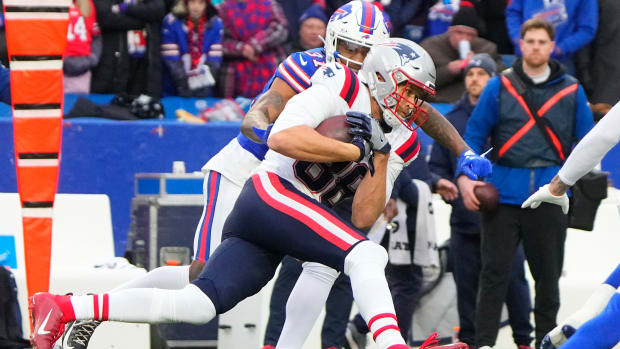Seahawks Buck Previous Unorthodox Trend For Traditional Draft Approach
For most of the John Schneider and Pete Carroll era in Seattle, dating back to the start of the 2010 season, they have worked hard developing their own way of drafting. For the first few years, they were historically good at it. They selected foundational pieces like Richard Sherman, K.J. Wright, Bobby Wagner and, of course, Russell Wilson.
Their approach allowed the Seahawks to build a Super Bowl-winning team.
That same approach usually consists of drafting players that fit their "system," regardless of external perception. Experts routinely question Schneider and company's process to the draft year after year. It's hard to blame them, considering the Seahawks have essentially burned high-end resources on the likes of Christine Michael, Malik McDowell and L.J. Collier.
Of the team's 33 draft picks since 2018, only seven are playing significant roles on the current Seahawks roster. Seattle's biggest wart in recent years has been Collier—its first-round selection in 2019. In 49 possible games over three seasons, he has made just 16 starts. He was a healthy scratch several times last season and has just 3.0 career sacks to his credit.
Over the years, the Seahawks have tried to outmaneuver and outwit other teams. To their detriment, they have occasionally bit off far more than they could chew. They passed on players most deemed to be obvious choices, such as Oklahoma center Creed Humphrey, who wound up going to the Chiefs and became an All-Pro as a rookie in 2021.
Instead, they have tried to look smarter than everyone else or pick players at positions that were not glaring needs to stockpile or utilize in a unique way. Be it arrogance or a long run of bad luck in an attempt to be shrewd in personnel moves, Seattle's roster is littered with holes.
On several occasions, Schneider had seemed obsessed with trading down in the draft simply to acquire more picks, exhibiting signs of an unhealthy "quantity of quality" approach. In 2022, however, that approach appears to have changed. The decision to trade star quarterback Russell Wilson to the Broncos kickstarted a new era of Seahawks football. While the coaching staff refuses to use the word "rebuild," this draft is vital for the future of the franchise and perhaps job security for both Carroll and Schneider.
Thursday came with the Seahawks sitting at No. 9 overall—their highest position since they selected Russell Okung pick No. 6 in 2010. Many assumed they would trade down, given Schneider's track record. Others figured they would try to outfox the rest of the league with a savvy, unexpected pick. Neither of those things came to pass. The Seahawks stayed put at No. 9 and selected Charles Cross, the top offensive tackle on the board and the seemingly obvious choice.
Some eyebrows raised due to their decision that didn't raise eyebrows. They made a sensible pick that just about any other team needing offensive line help would have made. Cross is one of the best pass protectors in the entire draft, presumably giving the Seahawks a left tackle of the future with All-Pro upside.
Next, pundits thought Seattle would trade back into the first round to reach for one of the quarterbacks in this class.
Instead, it was "crickets" from the Seahawks as the first round expired. They stood pat with their consecutive picks at No. 40 and No. 41, first selecting Minnesota pass rusher Boye Mafe, adding much-needed depth to the team's retooled rotation of edges.
The very next pick, Seattle showed its true colors with its selection of Kenneth Walker III. However, an argument can be made that there was a big need at running back, given the growing concerns about Chris Carson's ongoing rehab from neck surgery and the short-term commitment to Rashaad Penny.
Seattle continued to buck its own trend by taking Washington State tackle Abraham Lucas with pick No. 72. Most assume he will be the team's right tackle of the future.
In the fourth and fifth rounds, the Seahawks addressed another big need by drafting back-to-back cornerbacks in Coby Bryant and Tariq Woolen. They also double-dipped at defensive end with Ohio State's Tyreke Smith.
For those scoring at home, that is six draft selections being used for three big positions of need. Seattle drafted two tackles, two edge rushers and two cornerbacks, emphatically answering its biggest needs aside from the elephant in the room—quarterback.
In regards to the quarterbacks, the Seahawks had several opportunities to cave and take a signal-caller where everyone had pegged them to go. While taking a more traditional approach than previous years, they still stuck to their guns in not overreaching in pursuit of their next franchise passer.
While the Seahawks may be taking a more traditional approach to the draft, these picks suggest they are getting back to their roots. Strength in the trenches with a powerful running attack, complemented by solid defense is how Seattle became the most stable franchise in the NFC for the better part of a decade.
Drafting two tackles and a top running back is certainly a statement that the old Seahawk way is coming back.
"We picked two offensive linemen and a runner. I think it’s pretty clear that we wanted to make sure we have all the elements together so that we can be effective running the football and complement the rest of our game," Pete Carroll said following the draft. "That’s always a part of it."
"I think that three of the four picks really make a statement about the emphasis of what we would like to get done."
Now Schneider and Carroll will test out this more traditional way of drafting to see if it helps them truly get back to the point that brought a Lombardi Trophy to Seattle almost nine seasons ago.





